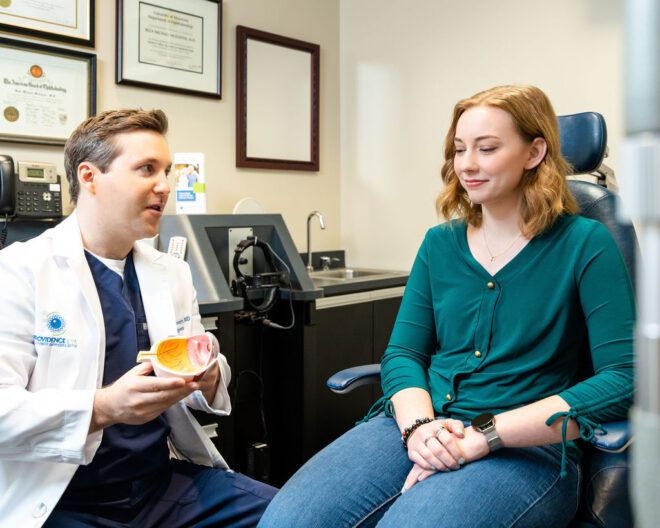
If you wear glasses or contacts when driving, watching television or any other activities that require clear distance vision, then you are likely myopic, also known as nearsighted. But glasses and contacts are not the only options you have.
Individuals with nearsightedness, also known as myopia, experience poor or blurred vision at a distance compared to objects and images that are closer, like the book you’re reading, the menu at a restaurant or a text message on your phone. This is an extremely common vision condition that can occur in one or both eyes and often requires the use of glasses, contacts or LASIK surgery for nearsightedness to correct blurriness.
If you struggle with nearsightedness, you’re not alone. According to the National Eye Institute, approximately 41.6 percent of all Americans are nearsighted, a significant increase since the 1970s. 30 to 40 percent of adults experience nearsightedness, with both genetic and environmental factors contributing to its development. One environmental factor contributing to nearsightedness is the tendency to focus more on near objects. Looking at phones, computer screens, books and tablets over extended periods can cause the eyes to elongate and not bend light the way they should.
Over the past few decades, especially in the age of smartphones and digitalization, it’s no surprise that the prevalence of myopia has grown faster than ever. The World Health Organization estimates that half of the world’s population may be myopic by 2050. It’s important to know the causes, symptoms and options for care, including LASIK surgery for nearsightedness.
With nearsightedness, the shape of your eye prevents light from bending the way it should. Instead of light being focused on your retina, light is focused in front of your retina, which causes blurry vision at greater distances. Myopia can also occur when the eye grows too long from front to back or if there are problems with the shape of your cornea (the clear front layer of the eye) or lens (an inner part of the eye that helps the eye focus).
To see clearly, we rely on the cornea and lens to focus light reflected from objects on the retina to form images. When light is focused in front of the retina, myopia occurs. This is the opposite of hyperopia, or farsightedness, where light is focused behind the retina due to a cornea that’s too flat or an eye that’s too short from front to back.
Yes, in fact, correcting nearsightedness with LASIK surgery is the most common reason for having LASIK. Myopia (nearsightedness) is a refractive error, an error that occurs when the eye has difficulties bending light properly. At Providence Eye & Laser Specialists, LASIK surgery for nearsightedness is performed by our expert surgeon Dr. Nunnery, who is a fellowship cornea specialist.
When a patient arrives at Providence Eye for LASIK surgery to correct nearsightedness, they are provided a light sedative to help them relax. Then, numbing drops are instilled into the eye, which takes away the sensation of pain, as well as the urge to blink. However, we do not rely on the patient to keep their eye open. During the procedure, the eye is positioned under a laser and held open by a sterile speculum. Patients describe feeling pressure from the speculum but no pain. A small corneal flap is created with our WaveLight FS200 laser to expose the corneal tissue that will be surgically removed and reshaped. The patient looks at a small target light of the 2nd laser, the WaveLight EX500, and pulses are then applied to the cornea, which is what corrects the vision. The actual time the laser is reshaping the cornea is just a few seconds per eye, depending on the amount of correction needed.
Saline solution is added to remove debris and assist in repositioning the corneal flap. The final step in this procedure is smoothing the corneal flap and drying the edges. This corneal flap begins to immediately heal and seal. This amount of time in the Providence Eye laser suite for LASIK for nearsightedness is only about 20 minutes total, the correction takes only a few seconds and the average recovery time is approximately 24 hours. The norm for patients who have LASIK for nearsightedness at Providence Eye & Laser Specialists is that they are 20/20 or better the very next morning!
If you’re interested in correcting nearsightedness, it’s important to be thoroughly evaluated by the actual LASIK surgeon who would do your procedure. At Providence Eye & Laser Specialists, Dr. Nunnery is happy to provide a complimentary consultation* to discuss your distance vision correction needs.
During the consultation, we’ll use our state-of-the-art technologies for diagnostic testing, non-invasive screenings and comprehensive vision checks. Once these painless tests are completed, you will be personally evaluated by Dr. Nunnery and advised if you are a good candidate for LASIK for nearsightedness. In some circumstances, an alternative to LASIK, such as PRK or EVO ICL, may be recommended for your personal situation. Or you may be advised that you are not a good candidate for any procedure at this time. If this is the case, your surgeon will be pleased to explain why so that you clearly understand your situation.
At Providence Eye, you can count on an experience that’s safe, convenient and proven across all touchpoints on your journey to better vision. We’re here to answer your questions and talk about your vision correction options, including LASIK for nearsightedness.
Schedule your complimentary consultation with one of our LASIK surgeons to get started.